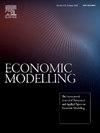参与全球价值链和FDI流入的生产率溢出效应
IF 4.7
2区 经济学
Q1 ECONOMICS
引用次数: 0
摘要
本文考察了外国直接投资(FDI)流入和参与全球价值链(GVCs)如何影响29个经合组织国家35个行业的劳动生产率。采用两步系统GMM估计来解决内生性问题,我们确定了与全球价值链参与类型(前向和后向)与FDI的技术构成之间相互作用相关的不同生产力溢出模式。我们的研究结果表明,前瞻性的全球价值链参与导致了更强的生产率增长,特别是当与高科技行业的FDI流入相结合时。相反,落后的全球价值链参与与低技术部门的FDI流入表现出更大的协同作用。这些研究结果强调了使FDI政策与一国全球价值链结构保持一致的必要性:高科技FDI在专门从事全球价值链前沿联系的经济体中更为有效,而低技术FDI在从事全球价值链后向联系的经济体中产生更大的生产率提高。研究结果为设计有针对性的投资策略以通过全球价值链整合提高生产率提供了重要的政策启示。本文章由计算机程序翻译,如有差异,请以英文原文为准。
Productivity spillover effects of participation in global value chains and FDI inflows
This paper examines how foreign direct investment (FDI) inflows and participation in global value chains (GVCs) influence labor productivity across 35 industries in 29 OECD countries. Employing a two-step System GMM estimator to address endogeneity, we identify distinct productivity spillover patterns associated with the interaction between GVC participation types—forward and backward—and the technological composition of FDI. Our results reveal that forward GVC participation leads to stronger productivity gains, particularly when combined with FDI inflows in high-tech sectors. Conversely, backward GVC participation exhibits greater synergy with FDI inflows in low-tech sectors. These findings underscore the need to align FDI policy with a country's GVC structure: high-tech FDI is more effective in economies specializing in forward GVC linkages, while low-tech FDI yields greater productivity gains in economies engaged in backward GVCs. The results offer important policy implications for designing targeted investment strategies to enhance productivity through GVC integration.
求助全文
通过发布文献求助,成功后即可免费获取论文全文。
去求助
来源期刊

Economic Modelling
ECONOMICS-
CiteScore
8.00
自引率
10.60%
发文量
295
期刊介绍:
Economic Modelling fills a major gap in the economics literature, providing a single source of both theoretical and applied papers on economic modelling. The journal prime objective is to provide an international review of the state-of-the-art in economic modelling. Economic Modelling publishes the complete versions of many large-scale models of industrially advanced economies which have been developed for policy analysis. Examples are the Bank of England Model and the US Federal Reserve Board Model which had hitherto been unpublished. As individual models are revised and updated, the journal publishes subsequent papers dealing with these revisions, so keeping its readers as up to date as possible.
 求助内容:
求助内容: 应助结果提醒方式:
应助结果提醒方式:


